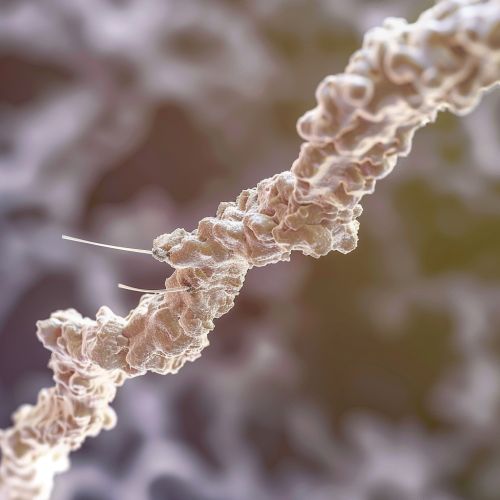Bacterial Flagellum: Difference between revisions
(Created page with "==Structure and Function== The bacterial flagellum is a complex, self-assembling structure that allows bacteria to move towards or away from different environmental stimuli, a process known as chemotaxis. The flagellum is composed of approximately 20 different types of proteins, totaling over 30 individual protein molecules. The structure of the flagellum can be divided into three main parts: the basal body, the hook, and the filament. <div class='only_on...") |
No edit summary |
||
| Line 2: | Line 2: | ||
The bacterial flagellum is a complex, self-assembling structure that allows bacteria to move towards or away from different environmental stimuli, a process known as [[Chemotaxis|chemotaxis]]. The flagellum is composed of approximately 20 different types of proteins, totaling over 30 individual protein molecules. The structure of the flagellum can be divided into three main parts: the basal body, the hook, and the filament. | The bacterial flagellum is a complex, self-assembling structure that allows bacteria to move towards or away from different environmental stimuli, a process known as [[Chemotaxis|chemotaxis]]. The flagellum is composed of approximately 20 different types of proteins, totaling over 30 individual protein molecules. The structure of the flagellum can be divided into three main parts: the basal body, the hook, and the filament. | ||
[[Image:Detail-77993.jpg|thumb|center|A close-up, detailed image of a bacterial flagellum, showing the distinct parts: the basal body, the hook, and the filament.]] | |||
The basal body is embedded in the bacterial cell envelope and serves as the motor for the flagellum. It is composed of a series of rings that are connected by a central rod. The basal body uses the flow of protons or sodium ions across the bacterial membrane to generate the torque needed for rotation. | The basal body is embedded in the bacterial cell envelope and serves as the motor for the flagellum. It is composed of a series of rings that are connected by a central rod. The basal body uses the flow of protons or sodium ions across the bacterial membrane to generate the torque needed for rotation. | ||
Revision as of 18:54, 8 May 2024
Structure and Function
The bacterial flagellum is a complex, self-assembling structure that allows bacteria to move towards or away from different environmental stimuli, a process known as chemotaxis. The flagellum is composed of approximately 20 different types of proteins, totaling over 30 individual protein molecules. The structure of the flagellum can be divided into three main parts: the basal body, the hook, and the filament.

The basal body is embedded in the bacterial cell envelope and serves as the motor for the flagellum. It is composed of a series of rings that are connected by a central rod. The basal body uses the flow of protons or sodium ions across the bacterial membrane to generate the torque needed for rotation.
The hook is a flexible joint that connects the basal body to the filament. It allows for the rotation of the filament and transmits the torque generated by the basal body to the filament.
The filament is the longest part of the flagellum and is composed of repeating subunits of the protein flagellin. The filament acts as a propeller, pushing the bacterium forward when it rotates.
Biogenesis
The biogenesis of the bacterial flagellum is a complex process that involves the coordinated expression of flagellar genes, the self-assembly of flagellar components, and the export of these components to the site of flagellum assembly. The process begins with the formation of the basal body, followed by the hook, and finally the filament.
The expression of flagellar genes is tightly regulated and occurs in a hierarchical manner. Early genes are expressed first and encode components of the basal body and the flagellar export apparatus. Once the basal body is assembled, it can act as a signal to induce the expression of middle genes, which encode components of the hook. Finally, the completion of the hook triggers the expression of late genes, which encode components of the filament and the chemotaxis system.
The assembly of the flagellum occurs at the bacterial membrane and is facilitated by the flagellar export apparatus, a type of Type III secretion system. The export apparatus recognizes flagellar proteins in the cytoplasm and transports them across the membrane to the site of assembly. The proteins then self-assemble into the flagellum in a process that is driven by the energy of protein-protein interactions.
Evolution
The bacterial flagellum is a prime example of a molecular machine, and its complexity has sparked debates about its evolution. Some proponents of intelligent design argue that the flagellum is irreducibly complex, meaning that it could not have evolved through gradual, step-by-step processes. However, most scientists reject this argument and propose that the flagellum evolved through a process of exaptation, where existing structures or genes acquire new functions.
Evidence for the evolutionary origin of the flagellum comes from comparative genomics and structural biology. Many components of the flagellum are homologous to components of other bacterial structures, such as the Type III secretion system. This suggests that the flagellum evolved through the modification and co-option of pre-existing structures.
Role in Disease
The bacterial flagellum plays a key role in the pathogenesis of many bacterial diseases. The flagellum allows bacteria to move towards host tissues and invade them. In addition, the flagellum can act as a virulence factor, triggering an immune response in the host.
Many pathogenic bacteria, such as Helicobacter pylori and Pseudomonas aeruginosa, use their flagella to colonize and infect host tissues. In these bacteria, the regulation of flagellar gene expression and assembly is often linked to the regulation of other virulence factors, highlighting the importance of the flagellum in bacterial pathogenesis.
